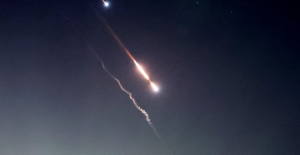Stanko said thunder means lightning and lightning can cause fires. He fears that he will have to sell half of his Routt County cows outside Steamboat Springs, Colorado, if he doesn't get enough hay to feed them.
Cattle ranchers feel the effects of the drought, which is threatening to worsen across the West. Some ranchers are forced to sell their animals because of lower hay yields. Ranchers often grow hay to feed their animals during winter, when the snow covers the grass they normally graze. This helps them avoid paying high feed costs.
Stanko's hay harvest this year is worse than last year. In heat waves and historically low levels of water in the Yampa River (his irrigation source), a single field produced only 10 bales.
Ranchers don't wait to feed fewer people.
Despite the fact that the peak season for the Loma Livestock Auction in western Colorado is in the fall, when most calves can be sold, sales were booming at the Loma Livestock Auction earlier this month. Ranchers are eager to sell their cattle while the market is still strong, which fuels the activity.
Buzz Bates, a Moab rancher, said that everyone is going to be selling their cows so it's smarter now than ever before the market gets saturated. He was selling 209 cow-calf pairs or 30% of his herd.
After a campfire set off in an abandoned campsite burned part of his pasture, Bates decided to trim the herd. This would have a negative impact on his ability to feed his animals.
Although weather has been an important factor in ranchers managing their land and livestock, these choices are increasingly focused on how drought-resistant herds can be, according to Kaitlynn Glover (executive director of natural resources, National Cattlemen's Beef Association).
George Raftopoulos (owner of the auction house) stated that if it rained four inches, there would be no cow to sell for five consecutive months.
Raftopoulos said that he encourages people not to part with their cows. He said that replacing them later might be more expensive than buying additional hay.
Cattle ranchers can find it difficult to manage herds. Culling herds often means selling off cows that have been selected for the best genetic traits for breeding. These cows are long-term investments that will pay dividends.
Jo Stanko was Jim's wife, and business partner. She noted that her cows were bred to withstand the extreme temperature swings in the region.
She said, "We live in very special places." "We need cattle that can handle high and low temperatures simultaneously."
The Stankos are looking for new ways to increase their ranching income as they reduce their herd. Offering hunting and fishing access on their land or winter sleigh rides is one option.
After they finish storing hay in September, the couple will be able to determine how many additional cattle they need. Although they hope to kill only 10, the couple is afraid that it could mean as many as 45 heads.
After a disappointing harvest, 21 heads were sold by the family last year. The crop this year is worse.
It's heating up with the heat. Jim Stanko stated that he couldn't cut the hay crop fast enough.

 Rishi Sunak wants a tobacco-free UK
Rishi Sunak wants a tobacco-free UK In Africa, the number of millionaires will boom over the next ten years
In Africa, the number of millionaires will boom over the next ten years Iran's attack on Israel: these false, misleading images spreading on social networks
Iran's attack on Israel: these false, misleading images spreading on social networks Iran-Israel: David Cameron wants the G7 to impose “coordinated sanctions” on Iran
Iran-Israel: David Cameron wants the G7 to impose “coordinated sanctions” on Iran New generation mosquito nets prove much more effective against malaria
New generation mosquito nets prove much more effective against malaria Covid-19: everything you need to know about the new vaccination campaign which is starting
Covid-19: everything you need to know about the new vaccination campaign which is starting The best laptops of the moment boast artificial intelligence
The best laptops of the moment boast artificial intelligence Amazon invests 700 million in robotizing its warehouses in Europe
Amazon invests 700 million in robotizing its warehouses in Europe Solar panels: French manufacturer Systovi announces the cessation of its activities due to “Chinese dumping”
Solar panels: French manufacturer Systovi announces the cessation of its activities due to “Chinese dumping” Tesla: canceled in court, Musk's huge compensation plan will again be submitted to shareholders
Tesla: canceled in court, Musk's huge compensation plan will again be submitted to shareholders Two, three or a hundred euros: who are the most generous customers with tips?
Two, three or a hundred euros: who are the most generous customers with tips? Boeing safety examined in US Senate, after whistleblower's revelations
Boeing safety examined in US Senate, after whistleblower's revelations Immersion among the companions of the Liberation
Immersion among the companions of the Liberation Provence-Alpes-Côte d’Azur releases several hundred thousand euros for the promotion of the work of Marcel Pagnol
Provence-Alpes-Côte d’Azur releases several hundred thousand euros for the promotion of the work of Marcel Pagnol A palm of honor distinguishes Studios Ghibli for all of their work
A palm of honor distinguishes Studios Ghibli for all of their work Gaby, a new play by Pagnol adapted into a comic strip
Gaby, a new play by Pagnol adapted into a comic strip Skoda Kodiaq 2024: a 'beast' plug-in hybrid SUV
Skoda Kodiaq 2024: a 'beast' plug-in hybrid SUV Tesla launches a new Model Y with 600 km of autonomy at a "more accessible price"
Tesla launches a new Model Y with 600 km of autonomy at a "more accessible price" The 10 best-selling cars in March 2024 in Spain: sales fall due to Easter
The 10 best-selling cars in March 2024 in Spain: sales fall due to Easter A private jet company buys more than 100 flying cars
A private jet company buys more than 100 flying cars This is how housing prices have changed in Spain in the last decade
This is how housing prices have changed in Spain in the last decade The home mortgage firm drops 10% in January and interest soars to 3.46%
The home mortgage firm drops 10% in January and interest soars to 3.46% The jewel of the Rocío de Nagüeles urbanization: a dream villa in Marbella
The jewel of the Rocío de Nagüeles urbanization: a dream villa in Marbella Rental prices grow by 7.3% in February: where does it go up and where does it go down?
Rental prices grow by 7.3% in February: where does it go up and where does it go down? Europeans: the schedule of debates to follow between now and June 9
Europeans: the schedule of debates to follow between now and June 9 Europeans: “In France, there is a left and there is a right,” assures Bellamy
Europeans: “In France, there is a left and there is a right,” assures Bellamy During the night of the economy, the right points out the budgetary flaws of the macronie
During the night of the economy, the right points out the budgetary flaws of the macronie Europeans: Glucksmann denounces “Emmanuel Macron’s failure” in the face of Bardella’s success
Europeans: Glucksmann denounces “Emmanuel Macron’s failure” in the face of Bardella’s success These French cities that will boycott the World Cup in Qatar
These French cities that will boycott the World Cup in Qatar Union Bordeaux Bègles-Clermont: at what time and on which channel to follow the Top 14 clash?
Union Bordeaux Bègles-Clermont: at what time and on which channel to follow the Top 14 clash? Football: Ada Hegerberg extends at OL until 2027
Football: Ada Hegerberg extends at OL until 2027 Basketball: suspended for life from NBA for fixing his match
Basketball: suspended for life from NBA for fixing his match Paris 2024 Olympic Games: boxer Estelle Mossely wants to parade on the Seine as a flag bearer
Paris 2024 Olympic Games: boxer Estelle Mossely wants to parade on the Seine as a flag bearer


















